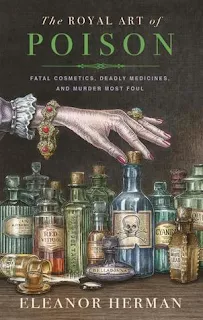The next book I read for the Non Fiction November Reading Challenge was The Royal Art of Poison - Fatal Cosmetics, Deadly Medicines and Murder Most Foul by Eleanor Herman.
It covers all of the toxic poisons contained in cosmetics and the disastrous medicines used by doctors and well-meaning apothecaries. It examines a collection of famous figures from history and their deaths, with modern reviews and theories on whether they were poisoned.
Heavy metal poisons include: arsenic, antimony, lead and mercury. Some notable plant poisons include: belladonna or deadly nightshade, hemlock, henbane, monks-hood or wolf's bane. Post renaissance poisons included: cyanide, sarin and strychnine.
I'm interested in the food poisonings in royal courts and was amused to learn that when servants carried food into a royal dining chamber:
It covers all of the toxic poisons contained in cosmetics and the disastrous medicines used by doctors and well-meaning apothecaries. It examines a collection of famous figures from history and their deaths, with modern reviews and theories on whether they were poisoned.
Heavy metal poisons include: arsenic, antimony, lead and mercury. Some notable plant poisons include: belladonna or deadly nightshade, hemlock, henbane, monks-hood or wolf's bane. Post renaissance poisons included: cyanide, sarin and strychnine.
I'm interested in the food poisonings in royal courts and was amused to learn that when servants carried food into a royal dining chamber:
"they placed them on a credenza, which takes its name from the various 'credence' tests for poison conducted there." Page 153The horn of a unicorn was believed to show indications of poison when it was waved over or dipped into food or drink. It wasn't a real unicorn horn but the tusk of a narwhal, a creature not discovered until the eighteenth century. Bezoar stones were also used.
As we now know, many poisons were used in cosmetics. For white teeth, ladies applied a powder:
"that contained grain, pumice stone, aloe, vinegar, honey, cinnamon, pearls, scrapings of ivory, quinces, and walnuts crushed into a paste and cooked with silver or gold foil." Page 607
The abrasive powder removed stains but also the tooth enamel.
Many medications contained heavy metals and the sicker a patient became, the more medicine they required often making them sicker. I knew about the humours, blood letting, enemas and poultices, but I didn't know that:
"whenever a member of the royal family was gravely ill, doctors would remove saintly body parts and entire corpses from churches and monasteries and put them in bed with the invalid." Page 793Outrageous! Herman introduces us to poisons used today that are almost untraceable and concludes with the poison hall of fame. This was an ingenious list containing the quickest poison (cyanide), the most painful poison (strychnine) and so on.
All in all, Herman gives us plenty of interesting tidbits from history to sink our teeth into. I could have done with less of the biographical history in each of the modern autopsies but it's a small complaint. The Royal Art of Poison was informative, unexpectedly funny (have you ever felt so sick you believed you were bursting in twain?) and highly recommended.
Carpe Librum!



































